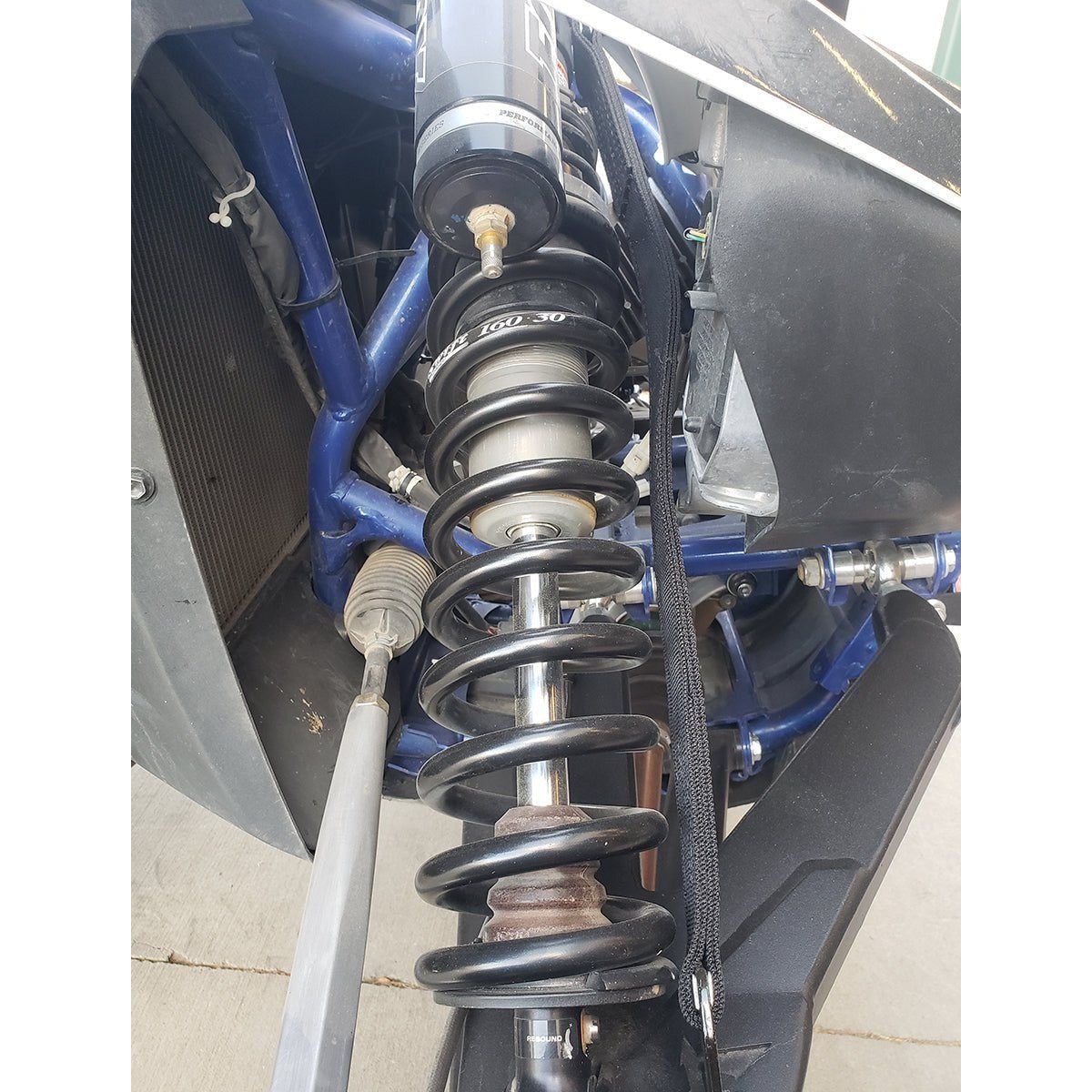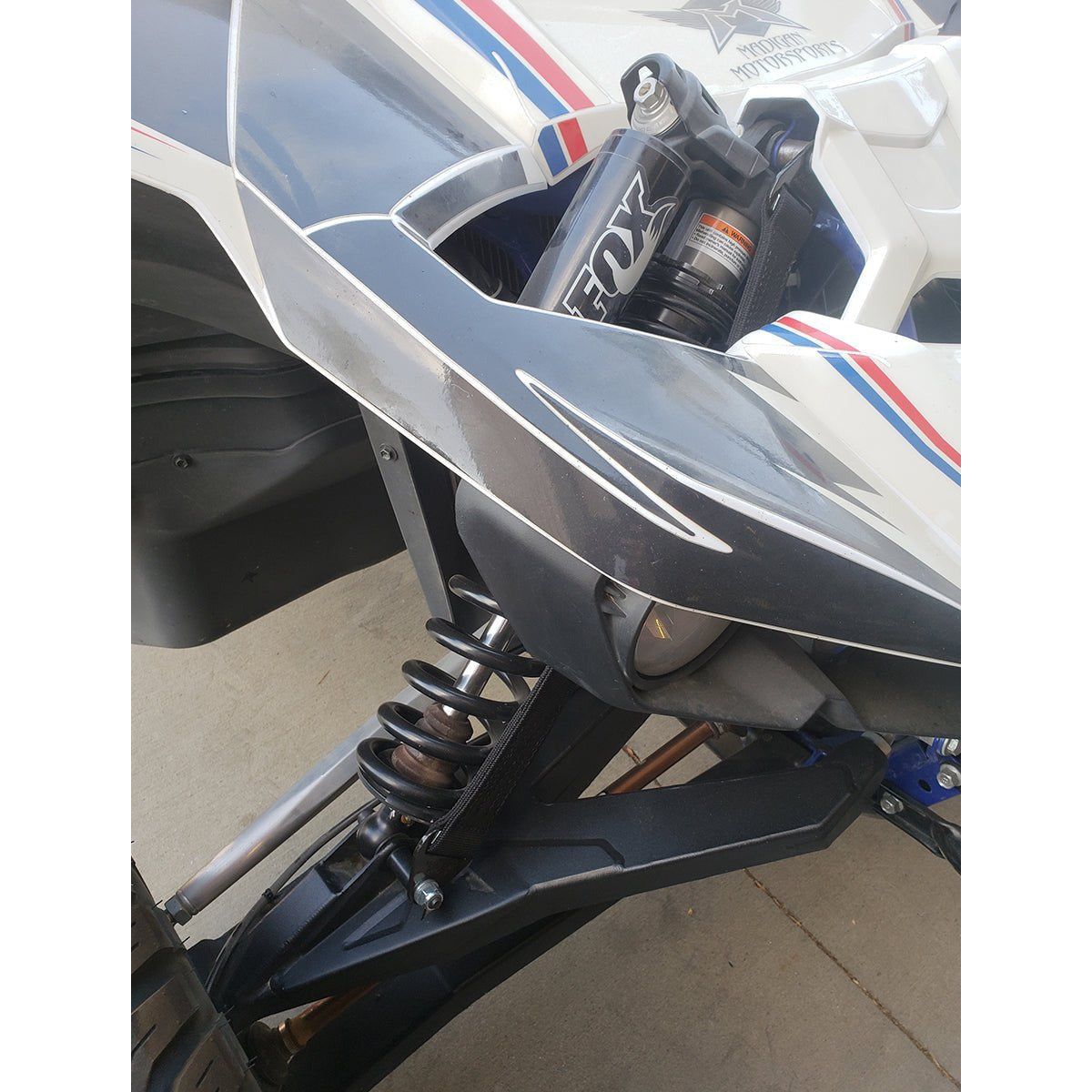Description
Description
Heavy-duty, 4 layer limit straps designed for the rigors of off-road.
Limit straps are vital in custom suspension setups helping to prevent damage to suspension and drivetrain components. Without limit straps, the force of your vehicle’s unsprung weight can cause damage to shocks when jumping or at high speeds over rough sections.
Limit straps can also prevent damage to your CV joints. All CV joints have a maximum amount of degree of deflection at which they can safely be run. With custom suspension setups. the deflection angle can go farther than the CV joint can handle, resulting in damage, shorter run life, and CV failure. Limit straps can prevent this by reducing the amount of maximum angle on your axles.
Every PRP limit strap is sewn 4 layers thick with 10,000lb webbing. Available in 1″ increments from 6″ to 38″ to fit your specific application. Measured from the center of each hole.
Sold individually.
HOW TO MEASURE WHAT LIMIT STRAP LENGTH YOU NEED
Figure out your mounting points – You must weld on mounting locations on both your chassis and your suspension. If you do not want to weld on your chassis, you could use longer shock bolts and spacers to mount your limit straps. However, this adds leverage and stress to a longer shock bolt, and is not ideal for that reason. For some UTV’s, PRP sells a limit strap kit that includes longer shock bolts and spacers so the strap will clear the shock body (See PRP’s UTV Limit Strap Kits).Most off-road shops sell weld-on tabs for limit straps that you can use to create a mounting point. We also highly recommend using an Adjustable Limit Strap Clevis (see below for more info). *You need to have these mounting points set, before you can measure what length strap you need.
Use a jack to raise the vehicle up, so that the wheels are off the ground – This allows your wheels and shocks to be at “full droop” (when the shocks are fully extended to their limit).
Measure the distance between your two mounting points – This is the maximum limit where your shocks will still be fully extended (and can cause damage over time). Lets call this measurement “X”,
Take your X measurement, and minus 1” of length for every 12” of strap. This is the corrected length that you actually need to order.
- Example – if your X measurement is 24”, then you need to remove 2” from the length, and the corrected limit strap length that you actually need is 22”.
- Why do we measure like this? – We want the limit strap to prevent the shock from fully extending (which it does above 24”) so we “limit” the amount of travel (by 2”) to stop it from fully extending, and to compensate for the amount that the limit strap will stretch.
- Limit Straps will stretch? Over time, the combined weight of the wheels/tires/arms pulling on the limit strap causes them to stretch out. Finding out the exact amount that each will stretch is hard to calculate. It depends on how heavy your un-sprung weight is, where on your suspension is the limit strap mounted, and how much leverage is being created by where you chose to mount the limit strap. At PRP we test our limit strap to a 10,000lb break strength, however its hard to know how much force each vehicle can create and how much stretch that will create. So as a basic rule of thumb to be on the conservative side – we recommend you factor in 1″ of stretch for every 12″ of strap when ordering. So most customers measure and adjust for that stretch when they purchase a strap (24″ measurement – needs a 22″ strap to compensate for stretch). Which means that when the strap is new, it will be limiting travel by an extra amount (2″)… then as the strap stretches over time, that number will decrease, and come closer to the ideal limiting measurement (23.5”-24″). So that the limit strap is just barely shorter than your maximum limit. If you want to fine tune this measurement, you can also use an Adjustable Clevis.
Check to see if your CV’s are Binding – After you measured, also check to see if you’re CV joints are binding. This can occur a lot of times on vehicles with long travel, where the shocks allow the wheels to travel a lot farther down, creating a extreme angle for the Axles/CV’s that cause it to bind.
- How to Check the CV’s – Set the car into neutral, and try to spin the tire. If the tire spins freely… then you’re fine. If the wheel catches/binds/grinds… then the CV or driveline is at too much of an angle. You need to remove the shock, lift the wheel up an inch and try again. Repeat this until the CV no longer binds, then measure the ‘X’ distance for the limit strap, and minus 1” of length for every 12” of strap.
HOW ADJUSTABLE CLEVIS’S WORK
Over time, the combined weight of the wheels/tires/arms pulling on the limit strap causes them to stretch (typically 1″ of stretch for every 12″ of strap). Because of this, most customers measure and adjust for that stretch when they purchase a strap (24″ measurement – needs a 22″ strap to compensate for stretch). Which means that when the strap is new, it will be limiting travel by an extra amount (2″)… then as the strap stretches over time, that number will decrease, and come closer to the ideal limiting measurement (23.5”-24″).
With an adjustable clevis, you have the ability to fine tune that measurement. Limiting the travel just enough to protect your shocks and CV’s, with out having to also limit travel by an extra amount. As the strap stretches out, simply adjust the clevis to re-tighten the strap. Keeping it at the optimal length to prevent damage to the shocks, or binding the CV’s.
Adjustable Clevis’s are also set up to be able to hold multiple limit straps (PRP’s can hold 1, 2, or 3 limit straps). Which is needed for heavier vehicles that have more weight with larger tires and arms (such as Ultra4, Trophy Lite, and Trophy Trucks)
How to Measure a Limit Strap that is going to be used with an Adjustable Clevis – Make sure that the clevis is fully extended while you measure your “X” length.
- If your X measurement is 0-24” you can usually just order the limit strap at the “X” length, and then tighten the clevis up over time (don’t have to adjust for stretch).
- If your “X” length is 24”+, then you might not be able to tighten the clevis an entire 3” or 4” over time. You should therefore minus 1” or 2” from the “X” length, and after the first few rides the limit strap should stretch out enough to be able to start tightening it with the clevis.
VEHICLE FITMENT
Universal
Payment & Security
Payment methods
Your payment information is processed securely. We do not store credit card details nor have access to your credit card information.













